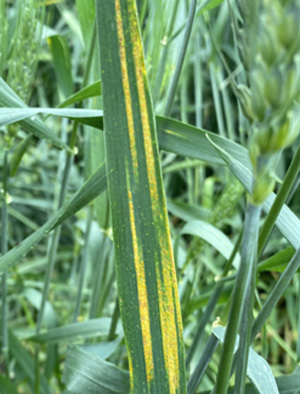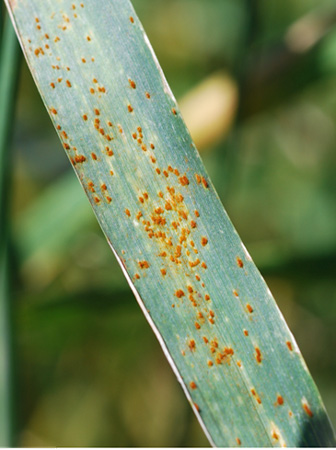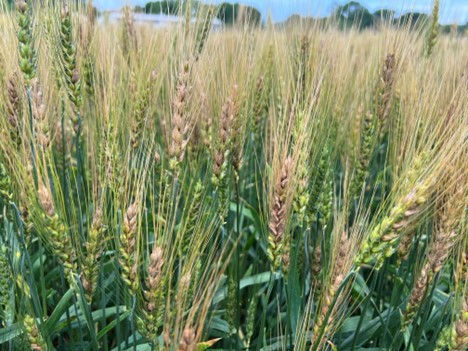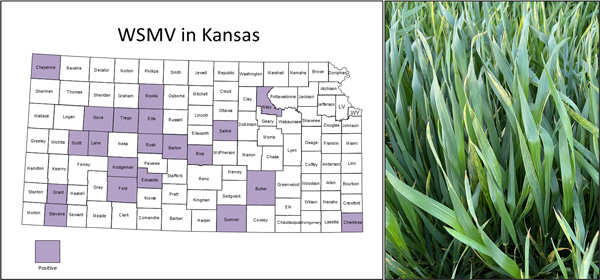It’s late April and the wheat crop is barreling into the flag leaf growth stages in many parts of the state. The rainy weather over the last week has had many wondering what the stripe rust outlook is for the season. Some producers are likely considering the need for a flag leaf fungicide application. The good news is that, even though we’ve received some moisture, the risk for stripe rust in the state remains low. We should continue scouting efforts over the next two weeks. In this article, we’ll walk through some of the reasons for the current low stripe rust risk and other diseases we should be thinking about in wheat right now.
The risk of stripe rust in Kansas remains low for 2025
On March 27, we reported that it was shaping up to be a low stripe rust year in Kansas (https://bit.ly/4iQPIP8). That trend still appears to be holding true. Stripe rust has been active at low levels in Texas since February, but conditions have not been favorable for disease development (Figure 1). This is important because stripe rust does not survive the winter in Kansas and needs to work its way up from the south annually. Low disease pressure in Texas means fewer spores are available to make their way north to Kansas. Additionally, at the time of this report, only trace levels of stripe rust were reported in Oklahoma. Additionally, there have been no reports of stripe rust yet this year in Kansas. For reference, in years when stripe rust is an issue, we generally detect the disease in Kansas before April 15. With all of this in mind, we believe it will be difficult for stripe rust to establish and “catch up” at this point in the season. Because of this, the risk of stripe rust remains low in the state. As a reminder, the probability of a positive return on a fungicide application greatly diminishes when disease pressure is absent. That said, producers should continue to scout and report any occurrences through the remainder of the season. These next two weeks will be critical for much of the state.

Figure 1. Typical symptoms of stripe rust. Spores are limited by the leaf veins, so they typically appear as yellow-orange stripes on leaves. Photo by Kelsey Andersen Onofre, K-State Research and Extension.
Should we be worried about leaf rust?
Reports from Texas indicate that leaf rust is active. As a reminder, leaf rust is a disease that typically shows up late in the season in Kansas (heading to flowering) due to its preference for slightly warmer temperatures (Figure 2). It is possible for leaf rust to occasionally survive the winter in Kansas. Watching for leaf rust development over the next few weeks will be important. Now is also a good time to check your variety resistance level to this disease: https://bookstore.ksre.ksu.edu/pubs/kansas-wheat-variety-guide-2024_MF991.pdf.

Figure 2. Typical symptoms of leaf rust. Note the cinnamon brown color of the spores. Unlike stripe rust, spores do not produce stripes on leaves. Photo by Erick DeWolf, K-State Research and Extension.
Let’s turn our attention to the scab risk over the coming weeks
Wet weather over the next couple of weeks will be critical for determining our scab risk in the state. As a reminder, scab infection occurs at flowering, but symptoms are often not visible for 14-21 days after infection (Figure 3). Because of this, we cannot scout for scab the way we would stripe rust or other foliar diseases. Fungicide decisions need to be made according to weather-based risk and the field’s yield potential. Wheat fields planted into corn residue are at the highest risk.
Fungicides such as Prosaro, Sphearex, Prosaro Pro, Proline, or Miravis Ace are known to suppress scab (head blight). Specific fungicide performance for scab and other diseases can be found here: https://bookstore.ksre.ksu.edu/pubs/EP130.pdf. Other fungicides are not labeled or not recommended for scab control, particularly products containing strobilurin (FRAC group 11 – azoxystrobin, pyraclostrobin, etc.)
Fungicides are most effective against scab when applied at early flowering (Feekes 10.5.1), but can provide protection even when used later in the flowering window. It is important to pay attention to pre-harvest intervals at this point of the season and follow guidelines provided on product labels. The products listed above either have a 30-day pre-harvest interval (cannot be applied within 30 days of harvest) or cannot be applied after Feekes 10.5.4 (end of flowering, watery ripe growth stage).

Figure 3. Fusarium head blight (scab) infection often begins with bleaching of infected spikelets and will progress throughout the head. When humidity is high, orange fungal structures are visible on the outside of the spikelet. The grain from infected heads may appear lightweight, white, or pink. Photo by Kelsey Andersen Onofre, K-State Research and Extension.
Wheat streak mosaic virus is active across the state
Wheat streak mosaic virus (WSMV) is active in the state (Figure 4 - right), with samples from 20 counties testing positive for this disease (Figure 4 - left). This season, the sister virus to WSMV, Triticum mosaic virus, has also been detected in 10 Kansas counties. Symptoms should be visible in affected fields now that the weather has warmed. A close inspection of symptoms and field pattern should help distinguish symptoms of WSMV from those of nutrient or other stresses. You can find a more complete article on wheat viruses from April 3, 2025, at https://bit.ly/43EGoJo.

Figure 4. Wheat streak mosaic virus occurrence (positive samples) as of April 23, 2025. The right panel shows wheat streak mosaic symptoms. Map by Chandler Day, K-State Plant Disease Diagnostic Clinic.
The K-State Plant Disease Diagnostic Laboratory can test for wheat viruses and other plant diseases. Please see this recent article for more detailed fees and sample submission information: https://bit.ly/4iIAmMe.
Kelsey Andersen Onofre, Extension Plant Pathologist
andersenk@ksu.edu
Tags: wheat disease fungicide stripe rust leaf rust fusarium head blight head scab